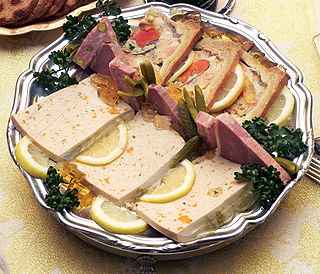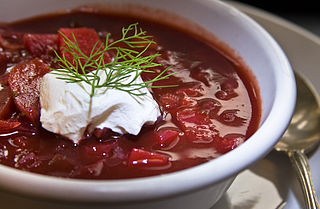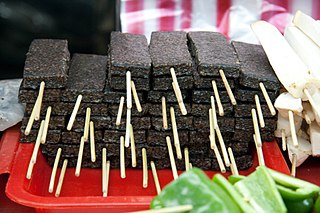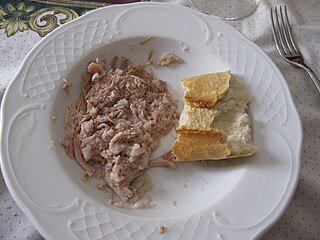
Minestrone is a thick soup of Italian origin made with vegetables and beans, and sometimes pasta or rice. It typically includes onions, celery, carrots, leaf vegetables, stock, Parmesan cheese, and tomatoes. Minestrone traditionally is made without meat, but it has no set recipe and can be made with many different ingredients.

A blood sausage is a sausage filled with blood that is cooked or dried and mixed with a filler until it is thick enough to solidify when cooled. Most commonly, the blood of pigs, sheep, lamb, cow, chicken, or goose is used.

Goulash is a soup or stew of meat and vegetables seasoned with paprika and other spices. Originating in Hungary, goulash is a common meal predominantly eaten in Central Europe but also in other parts of Europe. It is one of the national dishes of Hungary and a symbol of the country.

Offal, also called variety meats, pluck or organ meats, is the internal organs of a butchered animal. The word does not refer to a particular list of edible organs, and these lists of organs vary with culture and region, but usually exclude skeletal muscle. Offal may also refer to the by-products of milled grains, such as corn or wheat.

Polish cuisine is a style of food preparation originating in and widely popular in Poland. Due to Poland's history, Polish cuisine has evolved over the centuries to be very eclectic, and shares many similarities with other national cuisines. Polish cooking in other cultures is often referred to as à la polonaise.

Chinese Indonesian cuisine is characterized by the mixture of Chinese with local Indonesian style. Chinese Indonesians, mostly descendant of Han ethnic Hokkien and Hakka speakers, brought their legacy of Chinese cuisine, and modified some of the dishes with the addition of Indonesian ingredients, such as kecap manis, palm sugar, peanut sauce, chili, santan and local spices to form a hybrid Chinese-Indonesian cuisine. Some of the dishes and cakes share the same style as in Malaysia and Singapore, known as Nyonya cuisine by the Peranakan.

Belarusian cuisine refers to the culinary traditions native to Belarus. It shares many similarities with cuisines of other Eastern, Central and Northeastern European countries, based predominantly on meat and various vegetables typical for the region.

Smetana is the English-language name for the types of sour cream traditionally prevalent in Central, Eastern, and Southeastern Europe, and Central Asia. It is a dairy product produced by souring heavy cream. It is similar to crème fraîche, but nowadays mainly sold with 9% to 42% milkfat content depending on the country. Its cooking properties are different from crème fraîche and the lighter sour creams sold in the US, which contain 12 to 16% butterfat. It is widely used in cooking and baking.

Chả lụa or giò lụa is the most common type of sausage in Vietnamese cuisine, made of pork and traditionally wrapped in banana leaves.

Yakhni, yahni (Turkish), or yahniya, jahni (Albanian) is a class of dishes traditionally prepared in a vast area encompassing South Asia, the Middle East and the Balkans.

Blood as food is the usage of blood in food, religiously and culturally. Many cultures consume blood, often in combination with meat. The blood may be in the form of blood sausage, as a thickener for sauces, a cured salted form for times of food scarcity, or in a blood soup. This is a product from domesticated animals, obtained at a place and time where the blood can run into a container and be swiftly consumed or processed. In many cultures, the animal is slaughtered. In some cultures, blood is a taboo food.

Pringá is a Spanish dish popular in Andalusia, which consists of roast beef or pork, cured sausages such as chorizo and morcilla, and beef or pork fat slow-cooked for many hours until the meat falls apart easily. Pieces of crusty bread are used to pull away a little meat, sausage, and fat. It is a social dish eaten around the family dinner table.

A Schlachteplatte, Schlachtplatte, Schlachtschüssel, or Metzgete is a hearty German dish that primarily consists of boiled pork belly (Kesselfleisch) and freshly cooked Blutwurst and Leberwurst sausages. The cooking process produces sausage juices which, together with any split sausages, are used as a soup known as Metzelsuppe. As a result, in many places, e.g. in parts of the Palatinate, the entire festival and the meal in particular are known as Metzelsupp.

Kielbasa is any type of meat sausage from Poland and a staple of Polish cuisine. It is also known in other world cuisines; in American English, the word typically refers to a coarse, U-shaped smoked sausage of any kind of meat, which closely resembles the Wiejskasausage.

Pea soup or split pea soup is soup made typically from dried peas, such as the split pea. It is, with variations, a part of the cuisine of many cultures. It is most often greyish-green or yellow in color depending on the regional variety of peas used; all are cultivars of Pisum sativum.
















